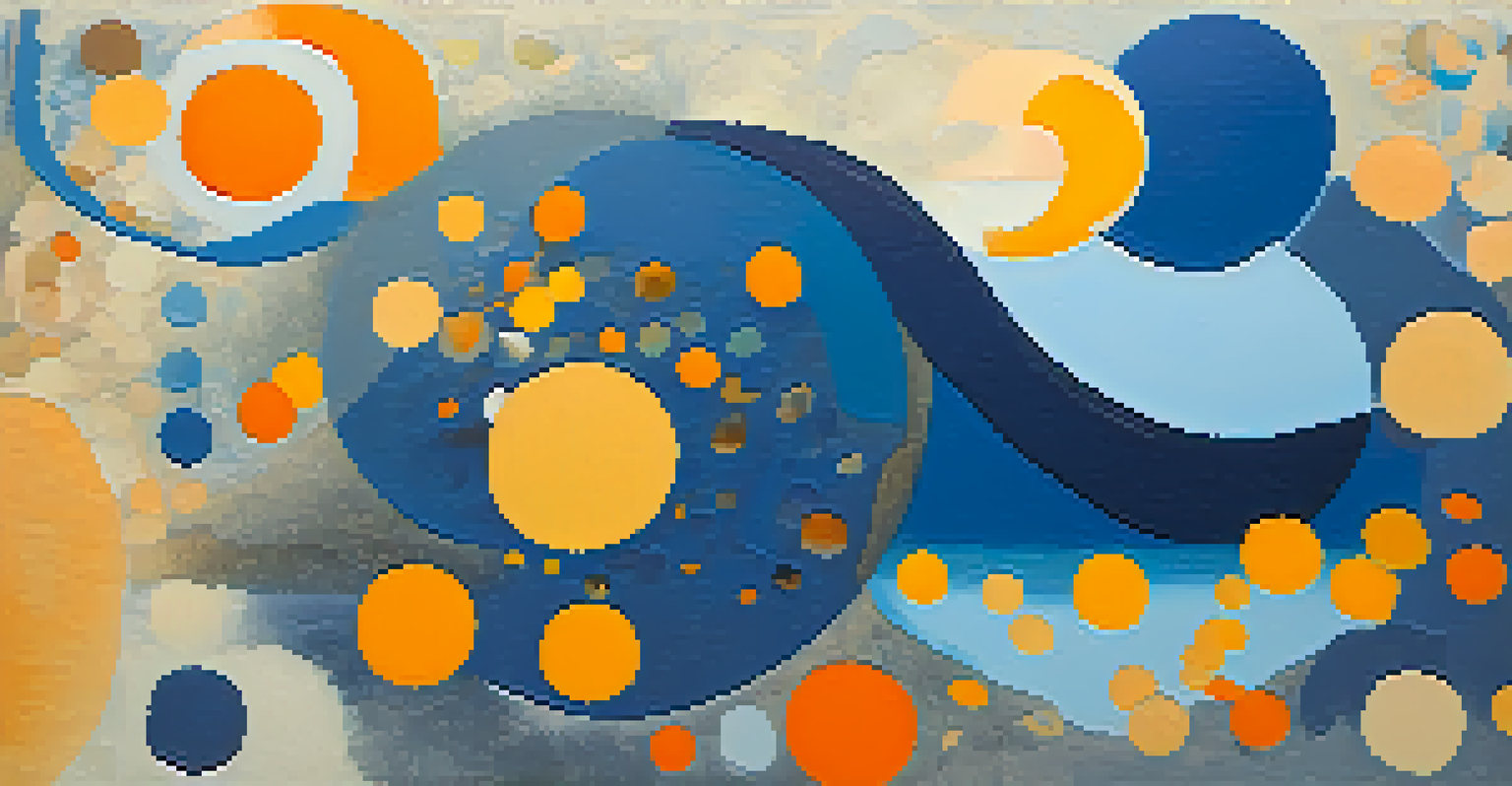Exploring Symmetry vs. Asymmetry in Painting Composition

Understanding Symmetry in Art Composition
Symmetry in painting refers to a balanced arrangement of elements that mirror each other. It creates a sense of harmony and order, often evoking feelings of calmness and stability. Think of the classic example of a butterfly—its wings are identical and symmetrical, which is pleasing to the eye.
Symmetry is not just a mirror reflection; it’s a balance that resonates with the spirit of the viewer.
Artists often use symmetry to guide the viewer’s attention to the focal point of the artwork. A symmetrical composition can lead to a straightforward interpretation, making it easier for the audience to understand the intended message. This technique is prevalent in many traditional works, such as Renaissance paintings.
However, relying solely on symmetry can sometimes result in a static feel. While symmetry offers balance, it may lack the dynamism that more varied compositions can provide, encouraging artists to explore other methods of arrangement.
The Allure of Asymmetry in Composition
Asymmetry, on the other hand, breaks the mold of traditional balance, creating a more dynamic and engaging visual experience. It can evoke a sense of movement and energy, drawing viewers' eyes across the canvas in unexpected ways. Take, for instance, the works of abstract artists like Jackson Pollock, where chaos reigns but creates a powerful emotional impact.

One of the fascinating aspects of asymmetry is its ability to provoke thought and interpretation. Unlike symmetrical designs, asymmetrical compositions can challenge viewers to look deeper and find meaning in the arrangement of elements. This unpredictability can make art feel alive and interactive.
Symmetry Creates Calm and Order
Symmetrical compositions evoke feelings of harmony and stability, guiding viewers’ attention to the artwork's focal point.
Additionally, asymmetry can highlight key elements by contrasting them against a more chaotic background. This technique not only captures attention but also allows for storytelling within the artwork, guiding the audience through an emotional journey without a defined path.
The Role of Balance in Art Composition
Balance is crucial in painting, whether achieved through symmetry or asymmetry. It’s about creating a visual equilibrium that resonates with viewers, making them feel comfortable while experiencing the artwork. Artists often consider weight, color, and texture to achieve this balance.
In art, as in life, the beauty often lies in the chaos of asymmetry.
In symmetrical compositions, balance is typically straightforward, as each side mirrors the other. However, in asymmetrical designs, artists must creatively distribute visual weight to maintain harmony even when elements differ in size and form. This balancing act can be a delicate dance that enhances the overall effect of the piece.
Ultimately, the balance in composition can influence the narrative of the painting. A well-balanced piece, whether symmetrical or asymmetrical, can lead to a more impactful emotional response from the audience, making them connect with the artwork on a deeper level.
How Symmetry and Asymmetry Affect Viewer Perception
The way symmetry and asymmetry are employed can significantly shape how viewers perceive and interpret a painting. Symmetric artworks often evoke feelings of calmness and reassurance, making them universally appealing. This can lead to immediate recognition of themes or subjects.
Conversely, asymmetrical compositions might elicit curiosity and contemplation, prompting viewers to engage more actively with the artwork. The unexpected arrangement of elements can surprise and intrigue, inviting a personal exploration of meaning and emotion. This engagement can create a memorable experience.
Asymmetry Engages and Provokes Thought
Asymmetrical designs create a dynamic visual experience that encourages deeper interpretation and emotional engagement.
Understanding these effects can help artists and art appreciators alike appreciate the nuances in painting. By recognizing how symmetry and asymmetry influence perception, we can better grasp the intentions behind the artwork and the emotional responses it seeks to evoke.
Practical Tips for Using Symmetry in Your Art
If you're looking to incorporate symmetry into your artwork, start by sketching out a central focal point. From there, mirror elements on either side to create balance. Using a grid can help maintain proportionality and ensure that your design remains cohesive.
Consider the emotional tone you want to convey. Symmetry often communicates stability and order, so think about how you can use this to enhance your message. Classic subjects like portraits or landscapes can benefit from a symmetrical layout, making the focal point stand out.
Don’t be afraid to experiment. While symmetry has its benefits, finding ways to mix symmetrical elements with asymmetrical ones can yield stunning results. This hybrid approach can add depth and intrigue to your compositions, making them more engaging for your audience.
Incorporating Asymmetry in Your Artistic Approach
To embrace asymmetry in your work, start by identifying a dominant element that draws the viewer’s attention. Position it slightly off-center to create a sense of movement and imbalance. This can make the piece more dynamic and visually stimulating.
Play with contrasts in size, color, and shape to enhance the asymmetrical composition. For example, pairing a large, bold shape with several smaller, delicate elements can create a captivating visual narrative. This contrast will engage viewers and lead their eyes throughout the piece.
Balance is Key in Art Composition
Achieving balance, whether through symmetry or asymmetry, is essential for resonating with viewers and enhancing the artwork's narrative.
Experimentation is key when working with asymmetry. Try different arrangements and step back to assess the overall balance. The beauty of asymmetry lies in its unpredictability, so allow yourself the freedom to explore and discover unique compositions.
Conclusion: Finding Your Unique Artistic Voice
Ultimately, the choice between symmetry and asymmetry in painting composition comes down to personal preference and artistic intent. Both approaches have their strengths and can convey distinct messages to the audience. Understanding the nuances of each can empower artists to make informed choices.
As you explore these concepts in your own art, remember that there’s no right or wrong way to create. The journey of discovering your unique voice is what makes art so enriching. Embrace the balance or imbalance that resonates with you the most.

Whether you lean towards the tranquility of symmetry or the excitement of asymmetry, each choice can lead to powerful expressions in your artwork. So grab your brushes, experiment, and let your creativity flow!